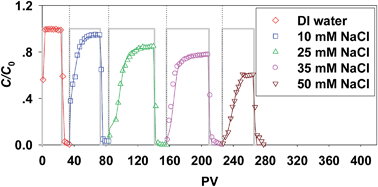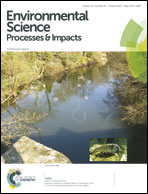Transport of graphene oxide nanoparticles in saturated sandy soil†
Abstract
We examined the transport properties of graphene oxide nanoparticles (GONPs) in saturated sandy soil, under different solution chemistry conditions and flow velocities. GONPs exhibited high mobility in soil, even at 50 mM NaCl. While at relatively high ionic strength GONPs were less mobile in soil than in quartz sand, the differences were not significant. At a concentration of 0.5 mM, Ca2+ significantly inhibited the transport of GONPs in soil, but only slightly inhibited the transport in quartz sand. This was because by complexing with the surface O-functionalities of both GONPs and soil components, Ca2+ could enhance the aggregation of GONPs and bridge GONPs and soil grains. Increasing pH from 4 to 9 only slightly enhanced the transport of GONPs in soil, probably because the mobility of GONPs was already high at low pH. The presence of 10 mg L−1 Suwannee River humic acid significantly enhanced the transport of GONPs in quartz sand at 35 mM, but only had a small effect for the transport in soil. This was possibly linked to the much smaller grain sizes and much more heterogeneous nature of the soil. Flow velocity had marked effects on the transport in soil, but essentially no effects on the transport in quartz sand. A two-site transport model incorporating both the blocking-affected attachment process and straining effects can effectively model the transport of GONPs. The high mobility of GONPs may have important implications for their environmental fate and effects.


 Please wait while we load your content...
Please wait while we load your content...